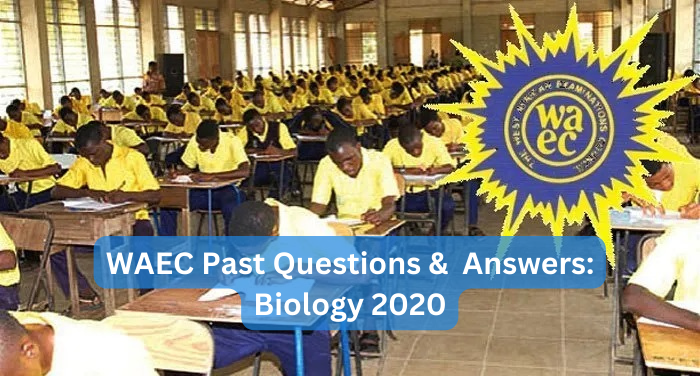WAEC Past Questions & Answers: BIOLOGY 2020

Welcome to our WAEC past question and answer series. In this post, we will be sharing ‘recent’ past questions and their answers for various subjects. Stay tuned enjoy while learning.
1. The hormone which regulates the amount of glucose in the blood us called?
A) Adrenalin
B) Auxin
C) Insulin
D) Thyroxine
2. Deamination occurs in the?
A) Kidney
B) Pancreas
C) Spleen
D) Liver
3. In an agricultural ecosystem, the biotic component consist of
A crops, pests and beneficial insects
B crops, temperature and humidity
C pests, beneficial insects and water
D crops, water and soil
4. Epiphytes growing on the branches of trees provide an example of the relationship known as?
A parasitism
B commensalism
C saprophytism
D holophytism
5. The hypha of rhizopus is said to be non-septate because it
A does not contain chlorophyll
B has no cross wall
C is vacuoled
D stores oil globus
6. The function of ribosome in cells is
A protein synthesis
B starch synthesis
C transport of material
D lipid storage
7. In which of the following does external fertilisation take place?
A toad
B lizard
C bird
D cockroach
8. The villus in the small intestine is significant because
A Increases the surface area for absorption
B increases the surface area for digestion
C assists in mixing digested food
D assists in filtering undigested food
9. The butterfly is of great economic importance because
A of it’s use in scientific studies
B it sucks nectar from flowers
C it adds to the beauty of the environment
D it pollinates flowers of crops and other plants
10. The bright colours of the comb and feathers in the peacock are for?
A sex differentiation
B beauty
C courtship
D defence
11. What is the term used to describe biotic and abiotic factors in the environment of the organism?
A habitat
B biome
C ecosystem
D ecological niche
12. Which of the following instruments is NOT used in measuring abiotic factors in any habitat?
A microscope
B windvane
C thermometer
D hygrometer
13. The smallest living organisms which share the characteristics of both living and non-living matter are
A bacteria
B fungi
C viruses
D protozoa
14. The process by which a red blood cell placed in distilled water absorbs water until it burst and release it’s content into the surrounding is known as
A osmosis
B plasmolysis
C turgidity
D hemolysis
15. Which of the following waste products in plants is excreted through the stomata and lenticles?
A carbon dioxide
B alkaloids
C tannins
D anthoocyanins
16. 
Use the diagram to answer the question
The vertebra illustrated is
A lumber
B thoracic
C caudal
D cervical
17. 
Use the diagram to answer the question
The neural arch is labelled
A i
B ii
C iii
D iv
18. The excretory structure in the earthworm is the
A malphighian tubule
B flame cell
C nephridium
D kidney
19. In which of the following vertebrates does the skin function as a respiratory surface
A rat
B lizard
C fish
D frog
20. The process of walking is under the control of the part of the brain called
A optic lobe
B olfactory lobe
C cerebellum
D medulla oblongata
21. The ability of the eyes to focus on both near and distance objects is termed
A image formation
B refraction
C hypermetropia
D accommodation
22. A group pf organism of different species living in a particular area is described as a
A colony
B community
C population
D niche
23. The biological association that contributes directly to succession in a community is
A competition
B predation
C parasitism
D commensalism
24. Floating microscopic heterotrophs are mostly grouped as
A phytoplankton
B zooplankton
C microbes
D nekton
25. Vaccination is carried out in order to
A check the production of poison
B increase the activities of white blood cells
C increase the number of red blood cells
D stimulate the production of anti-bodies
26. For growth to occur in organisms, the rate of
A anabolism must exceed that of catabolism
B catabolism must exceed that of anabolism
C food storage must be low
D food storage must be high
27. The probability of a baby being a boy or a girl depends on the contribution of the
A father’s sex cells
B father’s stoma-tic chromosome
C mother’s sex cell
D mother’s X-chromosome
28. Both recessive and dominant characters are found
A on different chromosome in the cell
B at the same logus of a homologous chromosome
C at a different loci of a homologous chromosome
D on the same chromatid in a chromosome
29. In a population of living things, the parameters of size, height, weight and colours are examples of
A continuous variation
B non-heritable variation
C discontinuous variation
D physiological variation
30. Use the diagram to answer the question.
The process of water loss and intake indicated by the arrows labelled i and ii are respectively
A evaporation and osmosis
B exhalation and osmosis
C osmosis and diffusion
D urination and diffusion
31. The noticeable adaptation of the animal to it’s aquatic habitat is the possession of
A webbed digits
B four limb
C wide mouth
D large eyes
32. Paternity disputes can most accurately be resolved through the use of
A blood group typing
B finger printing
C tongue rolling
D DNA Analysis
33. Use the table below to answer the question.
High relative humidity will be expected in Zones
A ii and iv
B ii and iii
C i and iii
D i and iv
34. Use the table to answer the question.
Which of the zones is likely to be a desert?
A i
B ii
C iii
D iv
35. When bacteria swim from cold to warm regions, this is known as
A positive phototaxis
B negative phototaxis
C positive thermotaxis
D negative chemotaxis
36. The only caste in the termite colony whose members can feed themselves are the
A workers
B reproductives
C soldiers
D nymphs
37. Which of the following os the best explanation for a child who is phenotypically short and born of two tall parents
A both parent possess genes for shortness
B the father possess a gene for shortness
C nature makes the child short
D None of the above
38. Which of the following vertebrates has the most simple structured heart
A reptile
B fish
C mammal
D Amphibian
39.
Use the diagram to answer the question.
The type of protective adaption exhibited by the animal is
A disruptive colouration
B flash colouration
C countershading colouration
D warning colouration
40. Use the diagram to answer the question.
The structure labelled i is
A photosensitive
B radiosensitive
C chemoreceptive
D tactile
41. The specific portion of a habitat which is occupied by a particular species is referred to as
A Ecological population
B Ecological niche
C Biotic community
D Ecosystem
42. In plants, respiration occurs in…
A The stomata and lenticel only
B Mesophyll cells only
C All living cells
D The root only
43. Which of the following is an example of discontinuous variation?
A The range in height of a pea plant from 30cm to 50cm
B Offsprings including two male cats and three female cats
C The colour of pear plants grown in the dark
D The adult body weight ranging from 50kg to 95kg
44. Which of the following type of soil has the highest water retaining capacity?
A Loam
B Laterite
C Clay
D Sand
45. Rabbits cannot survive in an aquatic habitat because they have
A fore and hind limbs
B no gills
C no fins
D no scales
46. Which of the following substances pass through the root cell membrane by osmosis?
A Ceil sap
B Carbon dioxide
C Oxygen
D Water
47. Trees in Savanna habitats usually have thick bark which mainly.
A Reduces the rate of transpiration
B Protect them from scorching sun
C Protect them from heavy winds
D Resist bush fires
48. Competition among individuals of a population increases the
A Number of organisms
B Availability of nutrient supplied
C Survival of the fittest
D Enlargement of the territory
49. In natural selection, Darwin proposed that evolution occurred because of the following conditions except…
A that nature selects those that will survive to reproduce their kind
B there is a fierce competition among the offspring
C that the weaker offspring are eliminated
D food and other needs are abundant
50. Which of the following substances has the highest amount of energy in joules per unit weight?
A Carbohydrates
B Fats
C Proteins
D Vitamins
51. Which of the following pairs of scientists discovered the Rhesis factor in human blood?
A Hooke and Lavine
B Darwin and Landsteiner
C Landsteiner and Lavine
D Hooke and Darwin
52. The study of an individual organism or a single species of organism and its environment is
A Autecology
B Ecological concepts
C Synecology
D Biotic composers
53. Which of the following is a nitrifying bacterium?
A Rhizobium
B Nictrobacter
C Azotobacter
D Pseudomonas
54. Which of the following is the effect of using artificial pollination in plant breeding?
A Production of healthy crops
B Lengthening the maturity time of crops
C Making crops susceptible to disease
D Improvement of the variety of crops
55. Only specially adapted micro-organisms are found in
A Salty water
B Humid air
C Moist soil
D Mouth cavities
56. Which of the following pairs of organisms are photosynthetic?
A Amoeba and paramecium
B Euglena and chlamydomonas
C Volvox and Rhizopus
D Nostoc and plasmodium
57. Which of the following statement about the similarities in plant and animal transport is correct?
A Materials and hormones are transported in fluid form
B The transport medium is made up of only tissues
C Their materials are transported in the same vessels
D Diffusion is not required
58. Which of the following is not a transmittable character in plants
A Habit of growth
B Resistance to environmental factors
C Life span
D Haemophilia
59. One of the following is a process of transmission of hereditary characteristics by chromosomes
A Genes relating to the same character occupy identical locations on the chromosomes
B Separation of homologous chromosomes into four daughter cells
C Separation of gametes during fertilisation
D Dictating the formation of a protein by a gene in a chromosome
60. Which of the reproductive system in mammals secretes a part of the seminal fluid which raises the pH of the fluid in the female reproductive system?
A Cowper’s gland
B Prostate gland
C Vas deferens
D Seminal Vesicle
Answers To Questions
- C
- D
- A
- B
- B
- A
- A
- A
- D
- C
- C
- A
- C
- D
- A
- B
- B
- C
- D
- D
- D
- B
- A
- A
- D
- A
- A
- B
- A
- B
- A
- D
- B
- A
- C
- A
- A
- B
- C
- D
- B
- C
- B
- C
- B
- D
- A
- C
- D
- B
- C
- A
- B
- D
- A
- B
- A
- D
- D
- A





